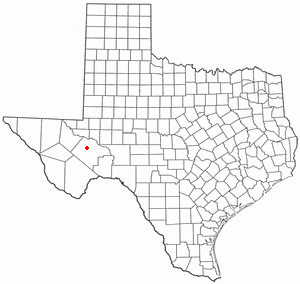Fort Stockton, Texas
|
|
Fort Stockton is a city located in Pecos County, Texas. As of the 2000 census, the city had a total population of 7,846. It is the county seat of Pecos CountyTemplate:GR.
| Contents |
Geography
Fort Stockton is located at 30°53'29" North, 102°53'6" West (30.891383, -102.885032)Template:GR.
According to the United States Census Bureau, the city has a total area of 13.3 km² (5.1 mi²). 13.3 km² (5.1 mi²) of it is land and none of the area is covered with water.
Demographics
As of the censusTemplate:GR of 2000, there are 7,846 people, 2,790 households, and 2,106 families residing in the city. The population density is 591.7/km² (1,531.3/mi²). There are 3,189 housing units at an average density of 240.5/km² (622.4/mi²). The racial makeup of the city is 70.06% White, 0.89% African American, 0.57% Native American, 0.76% Asian, 0.01% Pacific Islander, 25.16% from other races, and 2.54% from two or more races. 69.87% of the population are Hispanic or Latino of any race.
There are 2,790 households out of which 39.2% have children under the age of 18 living with them, 58.1% are married couples living together, 13.3% have a female householder with no husband present, and 24.5% are non-families. 21.7% of all households are made up of individuals and 9.6% have someone living alone who is 65 years of age or older. The average household size is 2.78 and the average family size is 3.25.
In the city the population is spread out with 30.1% under the age of 18, 9.9% from 18 to 24, 25.6% from 25 to 44, 20.8% from 45 to 64, and 13.6% who are 65 years of age or older. The median age is 33 years. For every 100 females there are 92.1 males. For every 100 females age 18 and over, there are 89.9 males.
The median income for a household in the city is $27,713, and the median income for a family is $30,941. Males have a median income of $25,735 versus $17,885 for females. The per capita income for the city is $12,834. 22.3% of the population and 19.7% of families are below the poverty line. Out of the total population, 30.6% of those under the age of 18 and 17.7% of those 65 and older are living below the poverty line.
History
Military scouts first camped near Comanche Springs as early as 1851. Continued military presence was placed in Camp Stockton by a detachment of twenty men of the 1st and 8th Infantry Regiments, U.S. Army in December, 1858. Camp Stockton was formally established in March 1859. It was named in honor of Captain Robert Field Stockton, a prominent navy officer in the Mexican War. He was the grandson of Richard Stockton, a signer of the Declaration of Independence.
The post protected travelers and settlers on the numerous roads and trails that crossed the rugged west and made use of the abundant water supply of Comanche Springs in West Texas. The first transcontinental trip initiated by the San Antonio-San Diego stage line passed by Comanche Springs on September 17, 1858. The next year the Butterfield-Overland Mail contracted to furnish through stages twice a week. The garrison formed detachments to protect the lines.
The U.S. Army withdrew from Texas during the Civil War and abandoned Fort Stockton in 1861. Confederate troops briefly occupied the site until they too withdrew, in 1862.
In July 1867, Fort Stockton was re-established by four Companies of the 9th U.S. Cavalry Regiment on 960 acres leased from civilian landowners, one-half mile northeast of the first post. Companies A, B, E, and K of the 9th Cavalry begin construction under the command of Colonel Edward Hatch. The 9th was one of the new regiments organized after the Civil War staffed with Black enlisted men. When the 9th Cavalry was moved to New Mexico in 1875, Colonel Benjamin Grierson's 10th Cavalry took over the duties of protecting the westward migration and trade routes.
About 87 percent of all soldiers garrisoned at Fort Stockton from 1867 until 1886 were Black troops of the 9th and 10th Cavalry Regiments and the 41st, 24th and 25th Infantry Regiments. Surmounting obstacles of harsh living conditions, difficult pay and racial prejudice, they gained a reputation of tenacity and bravery. Stationed continuously on the frontier during the years of Indian hostility Black regiments played a major role in the settlement and development of America's western frontier.
Currently Fort Stockton is in a state of decline as the oilfield that once sustained the area slowly dries up. The town itself claims to boast Over 950 motel rooms, 6 RV parks, 26 restaurants, Excellent municipal golf course, Pecan orchards, Unique shopping, National Register Historic District, Official Main Street.
Paisano_pete.jpg
A multicultural community conveniently located midway between San Antonio and El Paso on Interstate 10, Fort Stockton is only 100 miles southwest of Midland International Airport. Offering numerous motels and excellent restaurants, the town is within driving distance of major sights and sites in the Big Bend Country. Be sure to tour St. Genevieve Wines and Vineyard, the history-packed Annie Riggs Memorial Museum, historic Fort Stockton, and Paisano Pete, the world's largest roadrunner.
Fort Stockton has 657 economical and 293 moderate accommodations.

